Set Theory
Definitions
Definition Set
A set is a collection of objects, called elements.
We list its elements between curly brackets.
We list its elements between curly brackets.
Example
List all possible results when rolling a standard die 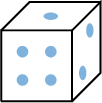 .
.
\(E=\{1,2,3,4,5,6\}=\{\) ,
,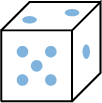 ,
,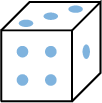 ,
,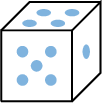 ,
,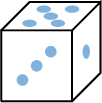 ,
,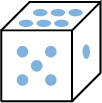 \(\}\).
\(\}\).
Definition Element
- An element is an object contained in a set.
- \(\in\) means "is an element of" or "belongs to".
- \(\notin\) means "is not an element of" or "does not belong to".
Example
\(2\in \{1,2,3,4,5,6\}\) and \(7\notin \{1,2,3,4,5,6\}\).
Definition Equal sets
Two sets are equal if they have exactly the same elements.
Example
Determine if the sets \(\{2,6,4\}\) and \(\{2,4,6\}\) are equal.
Yes, the sets \(\{2,6,4\}\) and \(\{2,4,6\}\) are equal because they contain the same elements: \(2\), \(4\), and \(6\).
Example
Determine if the sets \(\{1,2,3\}\) and \(\{1,2,4\}\) are equal.
No, the sets \(\{1,2,3\}\) and \(\{1,2,4\}\) are not equal because element \(3\) belongs to \(\{1,2,3\}\) but not to \(\{1,2,4\}\).
Cardinality
Definition Cardinality
\(\Card{A}\) denotes the number of elements in the set \(A\).
Example
\(\Card{\{1,2,3,4,5,6\}}=6=\) 

Complement
Definition Universal set
A universal set is the set of all elements considered.
Definition Complement
The complement of a set \(A\), denoted \(A'\), consists of all elements in \(U\) that are not in \(A\). Sets \(A\) and \(A'\) are said to be complementary.
Example
Given the universe \(U = \{1, 2, 3, 4, 5, 6\}\) and the set \(A = \{1, 3, 5\}\), find the complement \(A'\).
Start with the universe \(U = \{1, 2, 3, 4, 5, 6\}\).
The set \(A = \{1, 3, 5\}\) includes 1, 3, and 5.
The complement \(A'\) is all the elements in \(U\) that are not in \(A\):
$$A' = \{2, 4, 6\}$$
The set \(A = \{1, 3, 5\}\) includes 1, 3, and 5.
The complement \(A'\) is all the elements in \(U\) that are not in \(A\):
$$A' = \{2, 4, 6\}$$